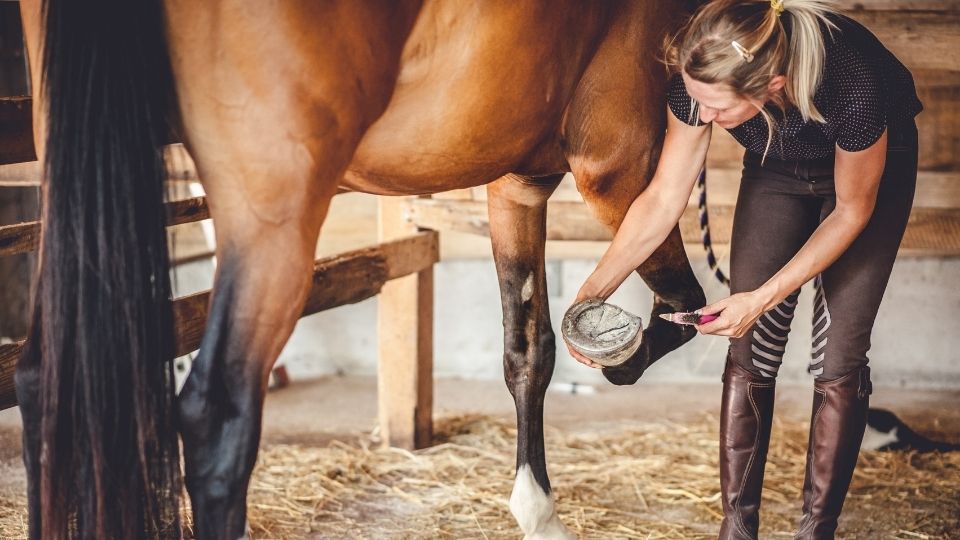
What to Do for a Split Hoof on Horse: Essential Tips?
Share
A split hoof on a horse can be a serious problem for both the horse and its owner. It can lead not only to discomfort for the animal but also to various complications if left untreated. For health-conscious pet owners, understanding what to do for a split hoof on horse is crucial in maintaining the well-being of their equine friends. In this article, we will explore the symptoms, causes, and effective treatment plans for a split hoof, ensuring your horse stays healthy and active.
Before we dive deep into the solutions, lets first understand the anatomy of a horse hoof. The hoof is a complex structure that protects the sensitive internal tissues, allowing for weight-bearing, movement, and overall comfort. Knowing how to care for a horse's hoof is essential for any devoted horse owner.

Understanding Split Hoof: What Is It?
A split hoof, also known as a hoof crack, occurs when there is a fracture in the hoof wall. This condition can manifest in different forms, such as vertical cracks or horizontal splits, depending on their cause. The horses activities, environment, and hoof care routine all play a significant role in the development of this condition.
Commonly seen in uneven terrains or during periods of rapid growth, a split hoof can be a significant sign of *neglect or stress*. If you suspect your horse is suffering from this ailment, it is essential to act quickly to prevent further complications.

Signs and Symptoms of a Split Hoof
Recognizing a split hoof early on can lead to more straightforward treatment. Here are some symptoms that pet owners should look for:
- Visible cracks or splits in the hoof
- Increased sensitivity or pain while landing
- Swelling around the hoof area
- Horses showing signs of discomfort, such as limping
- Frequent shifting of weight from one leg to another
If you notice any of these symptoms, consult with a veterinarian or a professional farrier as soon as possible.

Causes of Split Hoof Issues
Understanding the causes of split hooves is vital in preventing future occurrences. The most common causes include:
- Lack of proper hoof care: Regular trimming and maintenance are essential to keep hooves healthy.
- Environmental factors: Wet conditions can lead to softer hooves, making them more susceptible to cracks.
- Nutritional deficiencies: A lack of nutrients can weaken hoof structures.
- Genetic predisposition: Some horse breeds are more prone to hoof issues.
It's essential to maintain a healthy, balanced diet and ensure your horse has a suitable environment to minimize these risks.

Steps to Treat a Split Hoof
Now that we understand the basics, lets go through some effective steps on what to do for a split hoof on horse:
1. Consult a Professional
The first course of action when you detect a split hoof is to seek help from a veterinarian or a specialized farrier. They can assess the severity of the crack and recommend appropriate treatments tailored to your horses specific needs.
2. Clean the Affected Area
Thoroughly cleaning the split hoof is critical in preventing infections. Use a soft brush and warm, soapy water to clean the area, followed by a gentle rinse. Ensure there is no debris or dirt stuck in the crack.
3. Apply a Protective Dressing
Once the area is clean, it might be wise to apply a protective dressing designed for hoof injuries. This will help shield the affected area from dirt and bacteria. Depending on the severity, some owners opt for veterinarian-approved hoof sealants to seal the cracks temporarily.
4. Monitor and Care for Your Horse
Observe your horse regularly for any signs of discomfort or changes in behavior. Ensure they are not overexerting themselves during this healing process. Keeping the horse in a clean and dry environment can significantly aid in healing.
5. Adjust Nutritional Intake
Providing a balanced diet rich in essential nutrients, such as biotin, zinc, and calcium, can strengthen hooves over time. Consider consulting a nutritionist to tailor a diet suitable for your horses needs.
Preventive Measures to Avoid Split Hoofs
Preventing split hooves is always better than dealing with them afterward. Here are some preventive measures:
- Regular Hoof Care: Schedule regular visits from a qualified farrier to keep your horses hooves trimmed and in shape.
- Safe Environment: Ensure your horse resides in dry, clean stables, especially during wet conditions.
- Balanced Diet: Focus on nutrition that supports hoof health. Supplements specifically designed for hoof care can make a significant difference.
- Regular Exercise: Provide opportunities for your horse to exercise on different terrains to strengthen their hooves.
When to Seek Veterinary Assistance
Sometimes, split hooves can result in more severe issues like lameness or infections. If you notice:
- Persistent limping or weight shifting
- Severe swelling
- Foul odor coming from the hoof
Then its time to reach out to your veterinarian without delay. They may prescribe medication, perform surgery, or provide specialized care for your horse.
Additional Resources
Further understanding of hoof care can be advantageous. You can learn about trimming horse hooves or explore the structure of a horse hoof. These resources can help broaden your knowledge on hooves and general horse care.
FAQs
1. How long does it take for a split hoof to heal?
Healing time can vary; typically, minor splits can heal in weeks, while more severe cases may take months.
2. Can a horse still work with a split hoof?
It depends on the severity of the split. Always consult a veterinarian before continuing to exercise your horse.
3. What can I do to strengthen my horse's hooves?
Providing a balanced diet with hoof supplements, minimizing environmental stressors, and ensuring regular professional care is essential for strong hooves.
As an Amazon Associate, I earn from qualifying purchases.
